The POLLY PUSHER
2nd place winner of the - Jan 2002

An E-bird with attitude!
"Crank &
Bank" .mov clip
(right click and
save to drive - 7.5 megs)
INTRODUCTION:
Inspired by the infamous Push-E-Cat for it's durability:
http://www.rc-aero.com/kits/pushe/index.html
and "Sparky" Paul's inverted V tail camera
plane for its aesthetics:
http://www.angelfire.com/indie/aerostuff/VeeTailE-PhotoPlane.htm
I set out to design the perfect foamy
E-trainer.
I felt I had already achieved the
"virtually indestructible" goal in my prior "Wally Wing" project.
It utilizes a knock-off power pod and taped foam wings from a $4 hand chuck
Wal-Mart glider:
http://www.acesim.com/rc/wallywing.html
It has endured full speed contact with a
goal post and only sustained a minor dent in the LE. Even power dives
into the ground have never ended a day of flying.
I elected to borrow the same simple and
low cost construction techniques but have rudder and elevator control for
Polly. More accurately, ruddervators, using two mixed HS-81's in the
wing.
My first attempt had too much dihedral and
not enough tail moment resulting in anything but tame behavior. Exciting
flying fun to be sure, but she was no trainer. The spruce stick booms
left a lot to be desired in the strength department as
well.


After much trial and error, I
ended with a layout which has longer booms of carbon fiber tubing and less
dihedral in the wings. I also choose higher aspect ratio tail
feathers. Adding some sweep to the wing tip sections helped with the
ever-increasing nose length needed to achieve the proper CG without adding
redundant nose weight.
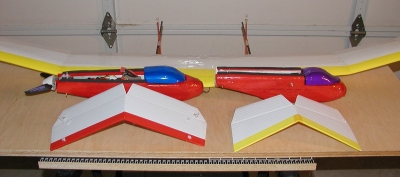
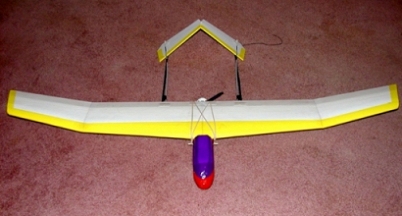
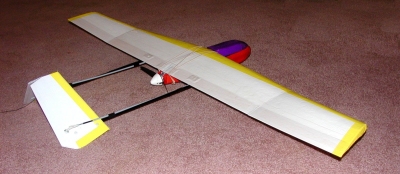
CONSTRUCTION
The stock glider's foam wings are
cut up and reglued to shape with 5 minute epoxy after adding a 1/8 by 1/2 inch
spruce spar cut in the bottom vertically at the quarter chord sweep
line. Thin ply doublers are added on each side of the spar at the
breaks. A 1.5 inch wide balsa trailing edge is added and some reinforced
strapping tape is applied on the LE and root for dent resistance.
Colored packing tape finishes it off.
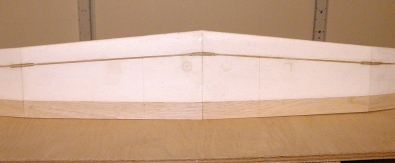
The redesigned power pod allows a
larger selection of 8 cell battery packs ranging from 1600 NiMH's to 1400AE
NiCad's. A stock Cermark S-400 6vt motor with a Kontronik Rondo 400
speed control installed turns a Graupner CAM 6.3 x 3 folder set up as a
pusher.
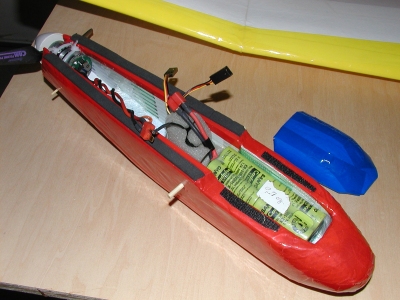
Constructed from the stock nose
of the "dime-store" glider's fuselage, the pod is reinforced with sidewalls of
corrugated plastic sign material (Coroplast/Corex) that double as motor
mounts. Two bamboo skewers and nylon wire ties are all that's needed to
secure it snuggly in place. An additional piece of this plastic is
attached with strapping tape under the motor enclosing the remaining open
area. This piece adds structural strength where the wing attaches as
well.
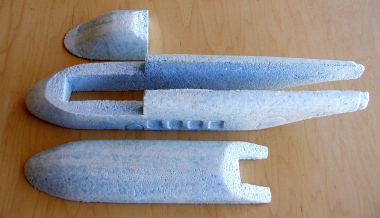

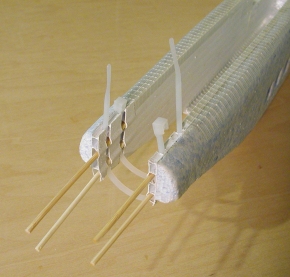
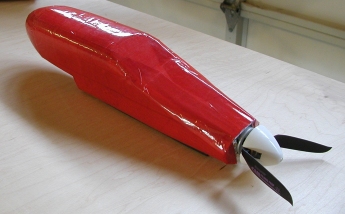
A hatch is cut out of the front
top for easy battery exchanges and is simply Velcroed in place. The
small gap under this "canopy" from the raised Velcro allows cooling air to
flow over the tops of the batteries and out the back past the motor. The
pod is held onto the wing with conventional rubber bands over pegs in the
front with the rear posts there just to restrain the bands from slipping off
the back.
The foam wrapped Hitec 555 receiver fits
securely behind the power pack completing the package. A detachable
antenna wire using a single servo connector stays with the wing and tail for
easy pod removal.

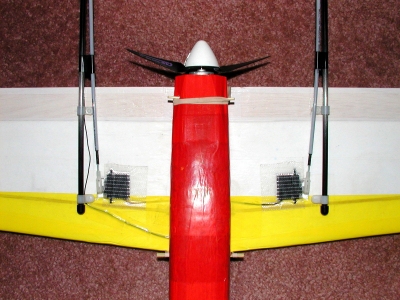
The tail is simply a single piece
cut from Coroplast that has a web removed to create the hinge line.
Small straws are taped over the LE and the TE is sliced and taped flat for
streamlining. It is firmly attached to the twin CF booms with nylon
cable clamps and bolts.
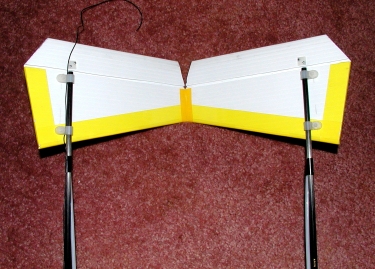
The booms attach to the wing in
the same manner with one nylon bolt through a thin-ply reinforced hole in the
TE and another into a threaded spacer glued into the wing against the spar.
Flexible control rods from the flush
bottom mounted wing servos run along the booms and attach to the control horns
on the top of the tail for positive tension during pitch-up loads.
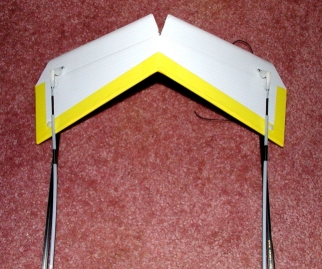
FLIGHT
The airfoil from the modified
"Sky Rider" foam wing appears to be similar to a 12 percent thick S3021
section.
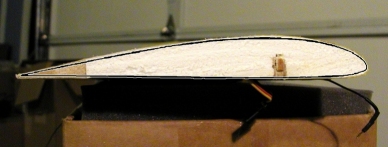
This wing continues to impress me
with its great glide ratio. Even with a 10.5 to 11.5 ounce per square
foot wing loading, a power off toss can get Polly far enough out that you
really dread the walk to retrieve her. In fact, since I had the CG
worked out from the first prototype, when I test glided her with all the final
modifications completed, I knew from the first 10 feet of glide she was
trimmed correctly. To save me the walk, I just hit the juice and never
looked back.
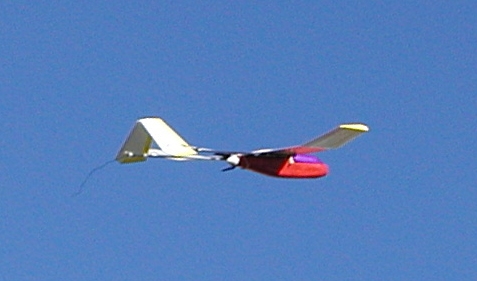
Continuous banked thermaling
turns are very relaxing and are surprisingly tight for her wing loading.
With good throttle management I routinely achieve 20 to 30 minute flights from
various 8-packs. The only complaint I can find in her flight
characteristics, and it's a minor one, is her roll response coming out of very
steep banked turns. There is noticeable yaw and lag time prior to the
roll. I may just be expecting too much from an RE plane at that
attitude, but this trait might be helped with some further vertical stab and
rudder sizing.
All in all I'm very happy with her current
feel. She's very comfortable to fly and holds a turn securely with just
gentle back pressure without any wobble or Dutch roll
effects.
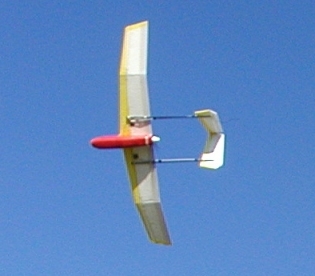
Common RE stunts can be flown
from level flight such as loops, stall turns, hammerheads, wingovers, etc.,
and even some inverted. Personally, I'm having trouble with decent
rolls, but I never could roll an RE ship. Best I get is a twisted
loop! Climb is very respectable at full throttle but might even be
spectacular with a gearbox. Although appearing that she might be
somewhat draggy, power off hi-speed flybys are surprisingly silent leading me
to believe she's pretty darn clean.
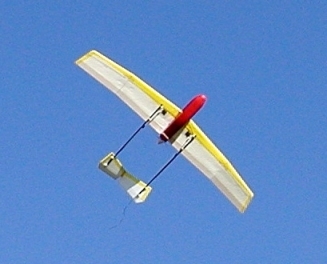
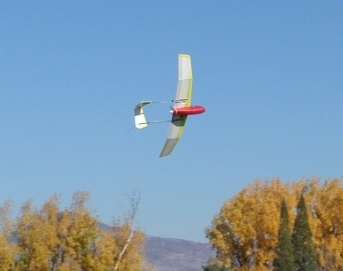
I'm constantly amazed at the
speed range of this wing. On 1/3 throttle you can hang on the bleeding
edge with good cues that you're nearing her limits. With the correct CG,
stalls are straight-ahead and mild with very quick recovery even if you start
to drop a wing. About the hardest aspect of flying Polly is judging
landings due to that extra long glide on final. Reminds me of my old
two-meter glider days.
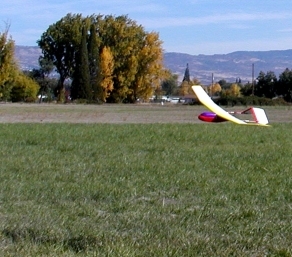
Survivability has been tested
with everything from a power dive in from 50 feet (don't ask) to botched
down-wind cart wheeled "landings". No real damage from anything except
for broken rubber bands, a wrinkled nose (mine and Polly's), relocated motor,
and a popped nylon boom bolt. With the advantages of such simple
crash-proof construction does come the price of some added preflight
responsibility however. Although it takes only seconds, the tail and
wing need to be eyeballed for alignment, and the pod position checked for
correct CG location before each flight. All in all, a small price to pay
I'd say.
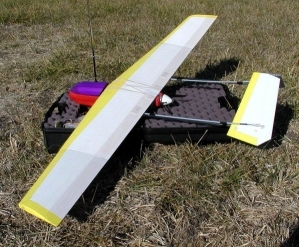
SPECS
Span - 54"
Length - 30"
Area - about 360 sq in.
RTF weight - tested from 26 to 29 oz.
Motor - S400 with 8) cell 1600mah NiMH or 1400AE NiCd packs
Prop - 6.3 x 3 Graupner CAM folder
Radio - Hitec Focus 3 FM with a 555
receiver mixing 2) HS-81 servos
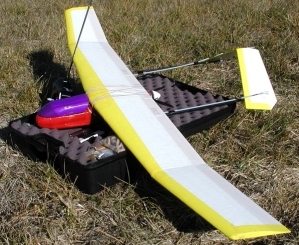
Polly gets flown lots as what you
might call a power assisted HLG. It's a real challenge poking around low
looking for a "hit", cutting power and winding her up. If I get spit
out, I can just power away to search for another source, or climb back up to
recatch the same one that kicked me out! Cheating? I guess, but
who cares? I'm having hours of great flying fun on just a few
pre-charged packs and most of it is close and in my face!
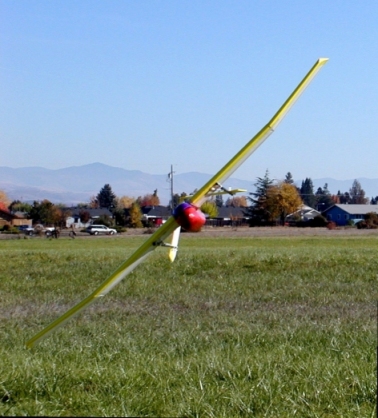
Even so, I'll still have to rate
this bird an outfield flyer, since she likes to move pretty quickly if you let
her.
Is she the perfect E-trainer? Well I
won't go that far but I will say that she's rekindled my affection with the
relaxed flying style that rudder/elevator designs make possible. With
her effortless soaring ability and forgiving nature she's a real pleasure to
fly. Maybe she's that one plane that can do many things well?
Being a tough foamy pusher, this bird
gives me a renewed confidence to brave flying low, slow, and close in without
worrying about racking her up. With her good performance and speed
range, she makes a fine duration power player as well. Add the fact that
Polly was built for less than $15 minus electrics in only a few easy evenings,
and she's a winner in my book!
Sorry, no plans available but if you want to build one, these dimensions
will get you going:
polly_build.html
1/02
Take a Polly tail
and add it to a Wally Wing.....A convertable sportster? Also possible aileron
trainer.
POLLY WALLY:
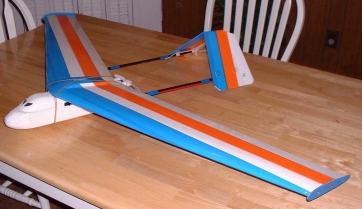
Outside Development
by Paul Des Biens
- flight tested 2/02
Keep wingin' it!
Ken Hill
HOME
(c) 2001, 2007 Ken Hill - Ace Sim RC -
Medford Oregon

























